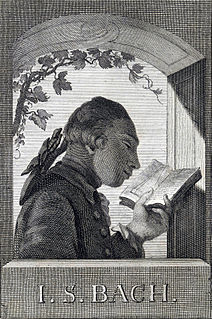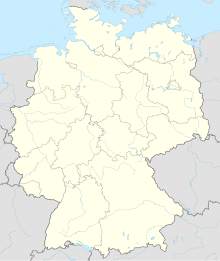
Georg Philipp Telemann was a German Baroque composer and multi-instrumentalist. Almost completely self-taught in music, he became a composer against his family's wishes. After studying in Magdeburg, Zellerfeld, and Hildesheim, Telemann entered the University of Leipzig to study law, but eventually settled on a career in music. He held important positions in Leipzig, Sorau, Eisenach, and Frankfurt before settling in Hamburg in 1721, where he became musical director of that city's five main churches. While Telemann's career prospered, his personal life was always troubled: his first wife died less than two years after their marriage, and his second wife had extramarital affairs and accumulated a large gambling debt before leaving him.

Carl Philipp Emanuel Bach, also formerly spelled Karl Philipp Emmanuel Bach, and commonly abbreviated C. P. E. Bach, was a German Classical period musician and composer, the fifth child and second surviving son of Johann Sebastian Bach and Maria Barbara Bach.

Henri-Gustave Casadesus was a violist, viola d'amore player, composer, and music publisher.
Carl Philipp Emanuel Bach: The Complete Works is a new critical edition of the music and keyboard treatise by C.P.E. Bach. The project was begun in 1998–99 in the wake of the aborted Carl Philipp Emanuel Bach Edition, and many of the same eminent music scholars associated with the earlier incomplete edition have become involved with the new one. From 1999–2014, the new edition was chaired by Christopher Hogwood. After his death in 2014, Robert D. Levin was appointed chair. The general editors are Darrell Berg, Peter Wollny, and Ulrich Leisinger. The edition is published by the Packard Humanities Institute. The current Editorial Guidelines are available in PDF format on the edition’s website: http://www.cpebach.org.
As Kapellmeister at Hamburg from 1768 to 1788, Carl Philipp Emanuel Bach composed 21 settings of the Passion narrative and 1 Passion oratorio.

Johann Adolph Rudolph Hass, usually known as Johann Adolph Hass, was a German maker of clavichords, harpsichords and possibly organs. He was the son of Hieronymus Albrecht Hass, also a maker of keyboard instruments.

Die Israeliten in der Wüste is an oratorio by Carl Philipp Emanuel Bach.

Ernst Wilhelm Wolf was a German composer.

Johann Sebastian Bach was a German painter. He was the son of composer Carl Philipp Emanuel Bach and the grandson of composer Johann Sebastian Bach.
The Weimarer Passion, BWV deest, is a hypothetical Passion oratorio by Johann Sebastian Bach, thought to have possibly been performed on Good Friday 26 March 1717 at Gotha on the basis of a payment of 12 Thaler on 12 April 1717 to "Concert Meister Bachen". It is one of several such lost Passions. Both the text and music are lost, but individual movements from this work could have been reused in latter works such as the Johannes-Passion. At one time, it was thought that the work set chapters 26 and 27 of the Gospel of Matthew to music, with interspersed chorales and arias, but current consensus is that it is possible that the text reflected a synopsis of two or more Gospel texts, as well as the interspersed chorales and arias.

Ich lebe, mein Herze, zu deinem Ergötzen, BWV 145, is a five-movement church cantata on a libretto by Picander which Johann Sebastian Bach, as its composer, probably first performed in Leipzig on Easter Tuesday, 19 April 1729. As a seven-movement pasticcio, with one of the added movements composed by Georg Philipp Telemann, it is an Easter cantata known as So du mit deinem Munde bekennest Jesum or as Auf, mein Herz!.
Christoph Nichelmann was a German composer and harpsichordist. He was second keyboard player in the Royal Ensemble of Frederick the Great.

The Magnificat, Wq 215, H.772, by Carl Philipp Emanuel Bach is a musical setting of the biblical canticle Magnificat as an extended composition for voices and orchestra in nine movements, composed in Berlin in 1749. It is the composer's first extant major choral composition.
Johann Sebastian Bach's music has been performed by musicians of his own time, and in the second half of the eighteenth century by his sons and students, and by the next generations of musicians and composers such as the young Beethoven. Felix Mendelssohn renewed the attention for Bach's music by his performances in the 19th century. In the 20th century Bach's music was performed and recorded by artists specializing in the music of the composer, such as Albert Schweitzer, Helmut Walcha and Karl Richter. With the advent of the historically informed performance practice Bach's music was prominently featured by artists such as Nikolaus Harnoncourt, Gustav Leonhardt and Sigiswald Kuijken.
The C. F. E. BACH motif is a musical motif, consisting of the notes C, F, E, B♭, A, C, B♮. The motif is a musical cryptogram, which represents the name of Carl Philipp Emanuel Bach with the initials of his name – Carl Philipp (Filippo) Emanuel Bach. The motif is based on the German note names, in which the note B♮ is named H and B♭ is named B, just as in the BACH motif. However, the initials of the composer’s name appear in a mixture of German and Italian, with Philipp rendered as Filippo.

The Composers Quarter Hamburg is a gathering of six museums in the Peterstraße in Hamburg-Neustadt, Germany. The associated museums have one or two classical composers as a theme who were born or have lived in the city of Hamburg.

Die Auferstehung und Himmelfahrt Jesu is an oratorio by Carl Philipp Emanuel Bach to a text by Karl Wilhelm Ramler on the subject of the resurrection and ascension of Jesus Christ. The first documented performance evidently took place in 1774, and was first publicly performed in 1778; it was further revised between 1778 and 1780. Along with the other oratorios that CPE Bach composed, Die Auferstehung und Himmelfahrt Jesu has been described as being "among the most important Protestant vocal works of the second half of the 18th century".
Christian Friedrich Gottlieb Schwencke was a German composer, pianist and editor of musical works. From 1789 to 1822, he was Kantor at the Johanneum and director of church music in Hamburg, succeeding Carl Philipp Emanuel Bach. He was an early publisher of The Well-Tempered Clavier by Bach's father, Johann Sebastian Bach.

Homage to Carl Philipp Emanuel Bach is a tapestry designed by the Danish architect Jørn Utzon. The tapestry was named by Utzon in honour of his favourite composer, Carl Philipp Emanuel Bach. It is 2.67 meters in height and 14.02 meters in length. It is made from wool and cotton.














